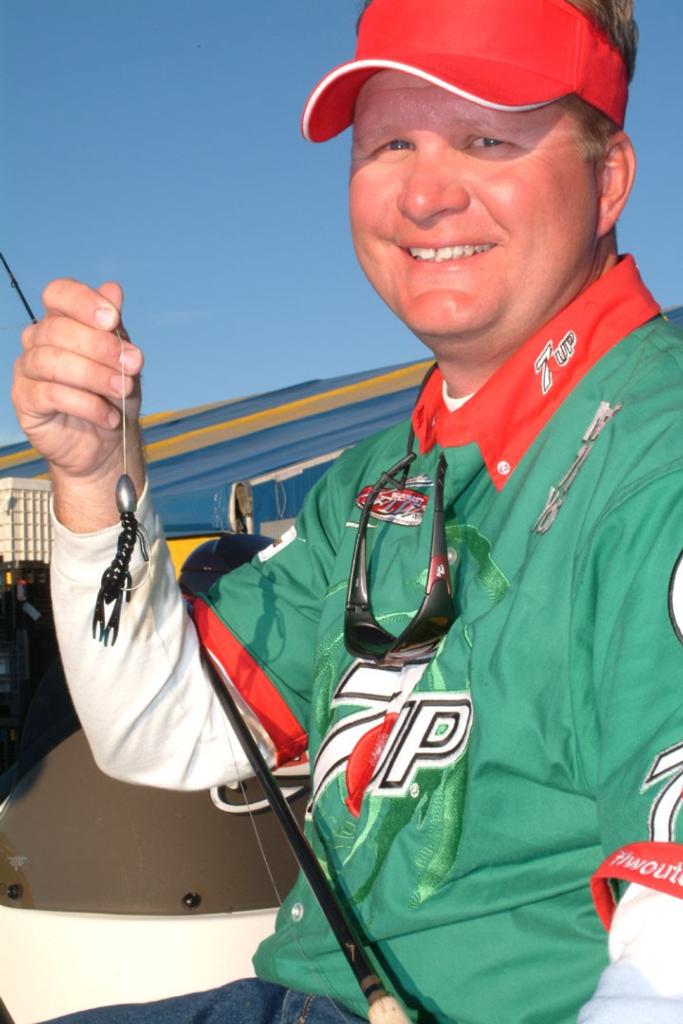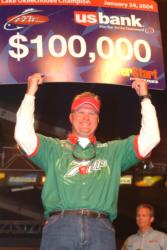Scheide’s ride
A closer look at FLW Tour rookie Ray Scheide and his tournament-winning pattern

Over the last several years, the Wal-Mart FLW Tour season opener on Lake Okeechobee has been a launching pad for a few fishing careers.
In 2002, a relatively unknown fishing guide named J.T. Kenney from Frostburg, Md., made his professional fishing debut by winning the Okeechobee Tour stop.
In 2003, Pat Fisher of Dacula, Ga., fortified his fishing resume with a Big O win.
Now add Ray Scheide of Russellville, Ark., to the list of pros who have hatched bassing careers under the FLW Tour tent at the Clewiston Wal-Mart.
Fishing in his first FLW Tour event, Scheide took home a $100,000 payday check and the notoriety that comes with being an FLW Tour champion.
But who is Ray Scheide? Where did he come from? And how did he pull off a major league win in his first FLW?
The 33-year-old Scheide is a familiar face in the Midwest, where he has been fishing the Okie Division of the BFL circuit for a decade. After consecutive BFL All-American qualifications in 2001 and 2002, Scheide stepped up to the EverStart Series Central Division events.
After making two EverStart Championships in 2002 and 2003, Scheide stepped it up again – this time taking his FLW Tour qualification.
Like any professional angler that waltzes under the FLW Tour big top to the tune of $100,000, Scheide has experienced his share of sacrifices and tough decisions.
From electrician to fishin’
For 10 years, Scheide enjoyed a secure job as an electrician.
“It was a real good job,” he said. “Good money, good insurance and time off to fish.”
In 2000, about the time Scheide was entertaining thoughts of taking his competitive fishing to another level, the company he worked for was restructured and the new management was not as enthusiastic about his angling endeavors.
“My time off got cut in half and that forced me to make a decision: work or fish,” he said.
After several long discussions with his wife, Michelle, they decided to pursue the fishing dream.
“I am fortunate to have a supportive wife – who, by the way, I met while working at Wal-Mart during college,” laughed Scheide. “Her father fished Red Man for years, so she was accustomed to tournament fishing. But more than that, she has made a lot of sacrifices so I could do this.”
With his wife behind him, Scheide cashed in his retirement plan and started a small sign business in Russellville, Ark., aptly named the Russellville Sign Company.
“Michelle has worked the business so we could pay the bills while I fished tournaments,” he added.
But Scheide had more hard decisions to make.
While the nonendemic corporate interests in professional bass fishing have taken the sport to unprecedented levels, they occasionally require anglers to make tough decisions. Scheide is an example.
“I had a regional corporate deal with Citgo,” he said. “But two days before I left for the Okeechobee FLW, I decided not to re-sign with them. That was another painful decision. Every pro out here strives to get a corporate deal, and I had one. Citgo has done a lot for me; I wouldn’t be here if it wasn’t for them. But the FLW Tour is where I wanted to be. Through the years I have come to know the Vannersons, Maxfields and Stakelys at FLW Outdoors; those folks are like family to me. I just feel at home at FLW.”
“Hopefully this win is like a when-one-door-closes-another-opens kind of thing,” he said. “I’m taking it as a good sign.”
Scheide did not really wait for the other door to open; he blew the hinges off at Okeechobee. After qualifying in seventh place with 16 pounds, 5 ounces and 20 pounds even, respectively, the first two days, he took a slim day-three lead with 14 pounds, 8 ounces.
On the final day, however, he toted 21 pounds, 9 ounces to the stage to win with a 13-pound margin. He had dialed into the right area with the right technique.
Unlike years past, Okeechobee tempted pros with a host of fishing options. With the lake’s stable conditions and mild weather, bass could be caught a number of different ways. Sight-fishing, casting Kinami Flashes and Senkos in spawning areas, flipping plastic craws into thick mats, spinnerbaits, top-waters and lipless crankbaits were all viable fishing techniques on Okeechobee.
The number of choices threw some pros off kilter. Just about the time they would commit to one pattern, they would get distracted by another.
“It’s hard to flip mats all day, catch nothing but 12-inchers, look on the other side of the boat, see a 6-pounder on bed, and then keep on flipping,” commented Energizer pro J.T. Kenney.
For Scheide, there was never any doubt about what he would be doing.
“I was committed to flipping from day one,” said Scheide. “I know it’s a winning technique on Okeechobee, especially in January when cold fronts are a constant threat. Plus, it’s my favorite way to catch bass.”
Amid all the dock talk about warming water, bedding bass and other techniques during the event, Scheide never veered from his 7-foot flipping stick, 65-pound-test Power Pro braided line and 1 1/2-ounce flipping weight.
But it was not as easy as just punching a craw through mats all day. Other pros that remained steadfast to the big stick did not fare as well. Last year’s champion, Snickers pro Pat Fisher, searched high and low for the big-fish flipping bite on Okeechobee.
“I found the big ones a couple of days during practice, but they wouldn’t stay put,” said Fisher. “When the water temperature reaches that 65-degree range, these fish get spawning on the brain, and they roam around much more than when it’s 55 to 60 degrees.”
“A lot of it is being in the right area,” said Castrol pro Mike Surman of Boca Raton, Fla., who loves flipping on Okeechobee. “Scheide was in a place where big ones were moving up.”
Scheide’s “right area” was quarter-mile-long stretch of matted hydrilla near the Belle Glade portion of Okeechobee. Scheide described his winning spot as buffer between a large eelgrass bed on the main lake and a big spawning bay closer to shore.
“Scattered about in the hydrilla bed were about 20 small mats of hyacinths that ranged in size from a car hood to a boat and truck hooked together,” he explained. “Those hyacinths clumps had been locked in that hydrilla bed a long time because they had shaded out the hydrilla underneath, creating big caverns.”
Scheide figured that Okeechobee bass used the protected caverns as staging spots, the same way bass in other lakes use deep water to stage up before the spawn.
Rattling the competition
During the first two days, there were other boats in the area, but Scheide “rattled” his competition, literally.
“I flipped a Terminator creature bait made of that new Snapback plastic because it would hold a 1-inch rattle that was superloud,” he said.
With the help of a 1 1/2-ounce weight, Scheide would punch the black/blue creature bait through a mat and then raise it to the top of the mat and shake it violently for as long as 30 seconds before getting a bite.
When the wind blew into his area on day three, he could no longer get the big creature bait through the mat.
“The wind compacted the vegetation, and it was difficult to get that big bait through,” he explained. “Normally, out of 10 pitches, I could get eight to break through. But when the wind compacted that stuff, I was only penetrating the mat once out of about 20 tries.”
To reduce the bait’s profile, Scheide switched to Billy Bowen’s namesake Gambler B.B. 3-inch Cricket in Bowen Silver Shadow to get through the mats. He used a 5/0 Owner wide gap-plus hook with the craw but rigged the hook to stick in the craw’s side instead of the belly.
“I was trying to make the bait as compact as possible,” he said. “I could get through the mat better with the hook in the side rather than perpendicular to the craw in the belly.”
The B.B. Cricket was also Scheide’s primary bait on day four when he weighed his largest catch of the tournament.
“The timing of this win is impeccable,” he said. “My goal at the beginning of the year was not necessarily to win a tournament but to make the championship and make a name for myself because I really had no idea how long I could afford to stay out here.”
